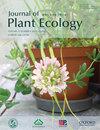超级多样性热点的社区水平预测:如何将堆叠的物种分布模型与森林清查数据进行比较?
IF 3.9
2区 环境科学与生态学
Q2 ECOLOGY
引用次数: 0
摘要
鉴于当前气候变化和人为影响的情况,生物多样性的空间预测对于支持保护和恢复行动至关重要。在这里,我们将不同的堆叠物种分布模型(S-SDM)与森林清单进行了比较,以评估S-SDM是否捕捉到了生物多样性热点地区物种丰富度和当地社区组成的新特性和地理模式。我们为大西洋森林151个地点的1499种树木样本生成了SDM。我们应用了四种模型叠加方法来重建植物群落:二元SDM(bS-SDM)、由最小凸多边形裁剪的二元SDMs(bS-SM-CROP)、受观察到的物种丰富度约束的叠加SDM(cS-SDM)和物种出现的最小凸多边形(MCP)。我们在物种丰富度、组成、群落预测指标以及贝塔多样性嵌套和更替的组成方面,将堆叠方法与当地群落进行了比较。S-SDM捕获了一般模式,bS-SDM-CROP是最节省的方法。物种组成在当地群落和所有堆叠方法之间存在差异,其中bS-SDM、bS-SDMs-CROP和MCP遵循嵌套模式,而物种更替在cS-SDM中最为重要。S-SDM在性能、遗漏和委托错误方面各不相同,导致对一些脆弱、濒危和极度濒危物种的预测失误。尽管与森林清查数据不同,但S-SDM捕捉到了当地社区的部分变化,代表了潜在的物种库。我们的研究结果支持使用S-SDM来支持粗略规模的生物多样性综合和保护规划,并警告在巨大多样性区域的地方规模上可能存在的预测失误。本文章由计算机程序翻译,如有差异,请以英文原文为准。
Community-level predictions in a megadiverse hotspot: how stacked species distribution models compare to forest inventory data?
Given the current scenario of climate change and anthropogenic impacts, spatial predictions of biodiversity are fundamental to support conservation and restoration actions. Here, we compared different stacked species distribution models (S-SDMs) to forest inventories to assess if S-SDMs capture emerging properties and geographic patterns of species richness and composition of local communities in a biodiversity hotspot. We generated SDMs for 1499 tree species sampled in 151 sites across the Atlantic Forest. We applied four model stacking approaches to reconstruct the plant communities: binary SDMs (bS-SDMs), binary SDMs cropped by minimum convex polygons (bS-SDMs-CROP), stacked SDMs constrained by the observed species richness (cS-SDMs), and minimum convex polygons of species occurrences (MCPs). We compared the stacking methods with local communities in terms of species richness, composition, community prediction metrics, and components of beta diversity - nestedness and turnover. S-SDMs captured general patterns, with bS-SDMs-CROP being the most parsimonious approach. Species composition differed between local communities and all stacking methods, in which bS-SDMs, bS-SDMs-CROP, and MCPs followed a nested pattern, whereas species turnover was most important in cS-SDMs. S-SDMs varied in terms of performance, omission and commission errors, leading to a misprediction of some vulnerable, endangered, and critically endangered species. Despite differing from forest inventory data, S-SDMs captured part of the variation from local communities, representing the potential species pool. Our results support the use of S-SDMs to endorse biodiversity synthesis and conservation planning at coarse scales and warn of potential misprediction at local scales in megadiverse regions.
求助全文
通过发布文献求助,成功后即可免费获取论文全文。
去求助
来源期刊

Journal of Plant Ecology
生物-植物科学
CiteScore
4.60
自引率
18.50%
发文量
134
审稿时长
3 months
期刊介绍:
Journal of Plant Ecology (JPE) serves as an important medium for ecologists to present research findings and discuss challenging issues in the broad field of plants and their interactions with biotic and abiotic environment. The JPE will cover all aspects of plant ecology, including plant ecophysiology, population ecology, community ecology, ecosystem ecology and landscape ecology as well as conservation ecology, evolutionary ecology, and theoretical ecology.
 求助内容:
求助内容: 应助结果提醒方式:
应助结果提醒方式:


